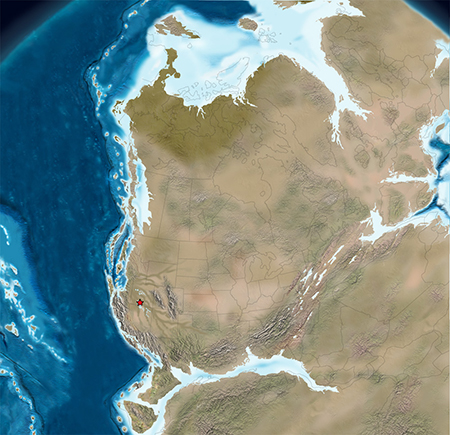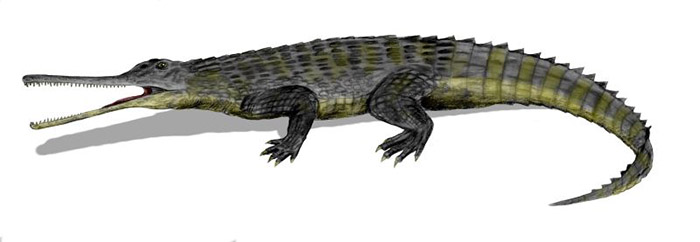
Map of Continents Through Time

Time in History: 215 million years ago (Triassic Period)
Environment Parameters & Graphs of Carbon & Oxygen
|
 |
Question of the Day:
How do Geologists establish the age of a rock?
Key Concepts
Dispatch
The route along the Paria River favors the runner who doesn’t mind a sloppy foot. The river runs through a canyon called The Box, and while the water was shallow here, it’s also wide in spots. The Youth Ambassadors clambered over a bridge of rocks, or jumped a narrow section, but the ones making the best time splashed through the water, soaking their shoes, socks and calves. In this way the Paria River favored a runner who enjoys a refreshing soaker. It was the same 215 million years ago. The animals that dominated were the animals that favoured the water: the crocodiles. The fossils found adjacent to The Box show that this region was once a rich and wet jungle environment, and very hot at about 120 degrees Fahrenheit this time of year. There were a few small dinosaurs at that time but early crocodiles, some as large as a stretch limosine, dominated them. So today, as the runners splashed through this former jungle, where the crocodiles once reigned, they delighted in a wet foot. But the crocodile’s dominance did not last forever. And in the same way, a runner who favors a wet foot in the eras to come, may be a runner left behind.
| Daily Video | Expert Video |
|---|---|
Photos of the Day
Coming Soon!
Character of the Day: Phytosaur
Had the Youth Ambassadors been able to visit the Grand Staircase Escalante National Monument 215 million years ago they might have seen a large crocodile-like creature similar to the Rutiodon pictured above. This was the age of crocodilians, and phytosaurs similar to this one grew from 3 to 8 meters in length. Phytosaurs were carnivorous reptiles that looked very similar to modern day crocodiles, and were one of the initial ‘winners’ after the P-T extinction event, dominating the early dinosaurs that lived at the time. Out of the ashes of the Paleozoic world many new groups arose, including flying reptiles, dinosaurs, modern lizards, mammals, and crocodilians. Crocodilians evolved first and initially gained the upper hand almost globally. Aside from the familiar aquatic predatory role, Triassic crocodilians also evolved into terrestrial herbivores (think armored cows) and predators (reptilian lions). Periods of great ecological chaos and extinction create voids that generally spur bursts of evolutionary innovation. Many new kinds of animals appear to replace the vacancies left by the victims.
Youth Ambassador Activity
At the end of the run on Day 2 the Youth Ambassadors will examine the differences between crocodilians and dinosaurs found in the Grand Staircase Escalante National Monument. Near their campsite they will find the Chinle Formation and catalog the overall diversity, biological affinities, and general ecology of the fossilized organisms that are characteristic of the late Triassic of southern Utah. They will summarize their findings, noting the relative abundance of crocodilians versus dinosaurs.